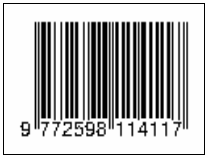Trade policy and Green Growth
Abstract
Keywords
Full Text:
PDFReferences
Antweiler, W., B. R. Copeland and M. S. Taylor (2001): “Is Free Trade Good for the Environment?”, American Economic Review 91(4), 877 – 908.
Barro, R. J., & Sala-i-Martin, X. (1995). Economic Growth. New York: McGraw HIll Inc.
Bran, F., and Ioan, I. (2012). Sustainable Development Conditions for Survival of The Planet, Agro Food and Rural Economy Competitiveness in Terms of Global Crisis ProQuets, Economics of Agriculture SI-1 UDK: 502.131.1, 59, 78-85.
Brock, W. A., & Taylor, M. S. (2005). The Green Solow Model. Journal of Economic Growth, 15 (2010), 127-153.
Brock, W. A., & Taylor, M. S. (2015). The Green Solow Model. Journal Econ Growth, Springer, 15, 127-153. doi: 10.1007 / s10887-010-9051-0
Brunnermeier, S. and A. Levinson (2004), Examining the Evidence on Environmental Regulations and Industry Location," Journal of Environment & Development, 13, 6-41.
Birdsall, Nancy; et al. (1993). Trade Policy and Industrial Pollution in Latin America: Where are The Pollution Haven?. The Journal of Environment & Development. 2 (1):137-149.
Cato, M. S. (2009). Green Economics: An Introduction to Theory, Policy and Practice. London: Earthscan.
Cobb, C. W., & Douglas, P. H. (1928). A Theory of Production. American Economic Review, 18: Suppl. (1928), 139-156.
Cole, M.A. and R.J.R. Elliott (2005), FDI and the Capital Intensity of `Dirty' Sectors: A Missing Piece of the Pollution Haven Puzzle," Review of Development Economics, 9, 530-548.
M. A. Cole, R J.R. Elliott, “Determining the Trade–Environment Composition Effect: the Role of Capital, Labor and Environmental Regulations”, Journal of Environmental Economics and Management 46: 363–383, 2003.
Dobson, A. (2000). Green Political Thought. Abingdon: Routledge.
Goulder, L. H. (2013). Market for Pollution Allowances: What are the (New) Lessons? Journal of Economic Perspectives, 29 1 (WInter 2013), 87-102.
Grossman, G. M., & Krueger, A. B. (1991). Environmental impacts of a North American Free Trade Agreement. Working Paper 3914. Cambridge MA: National Bureau of Economic Research, NBER.
Harrod, R. F. (1939). An Essay in Dynamic Theory. The Economic Journal, Vol. 49, No. 193 (Mar. 1939), 14-33.
Jones, C. I., & Romer, P. M. (2009). The New Kaldor Facts: Ideas, Institutions, Population, and Human
Capital. Paper presented at the the January 2009 annual meeting of the American Economic Association on "The Secrets of growth: What have we learned from research in the last 25 years?".
Karimi, S. (1995). Market Structure, Income Distribution and Poverty. Paper presented at the Upgrading Research Lecturer Kopertis Region X, August 3, 1995, Padang.
Karimi, S. (2012). Integration of Green Economy. Paper presented at the Workshop on Current Fiscal, 14 to 17 August 2012, the Fiscal and Financial Policy Board of the Ministry of Finance, Jakarta.
Kennet, M., & Heinemann, V. (2006). Green Economics: setting the scene. Aims, context, and philosophical underpinning of the distinctive new solutions offered by Green Economics. Int. J. Green Economics, 1, Nos. 1/2, 68-102.
Keynes, J. M. (1936). A General Theory of Employment, interest and money. The ISN. Retrieved from www.isn.ithz.ch website:
Kellenberg, D.K. (2009), An Empirical Investigation of the Pollution Haven Effect with Strategic Environment and Trade Policy," Journal of International Economics, 78, 242-255.
Lane, D. H. (2007). A Guide to Measures of Trade Openness and Policy: Indiana University South Bend.
Liddle, B. (2001): “Free trade and the environment-development system”, Ecological Economics 39, 21 – 36.
Mathews, J. A. (2011). Naturalizing capitalism: The Next Great Transformation. Futures, Elsevier.
Park, J. (2013). The Evolution of Green Growth Policy: An Unwelcome Intrusion on Global Environmental Governance? Journal of East Asian Economic Integration, 17 # 2 (June 2013), 207-241.
Ramsey, F. P. (1928). A Mathematical Theory of Saving. The Economic Journal, 38 152 (Dec., 1928), 543-559.
Saito, K., & Yakita, A. (2008). Optimal Environmental Policy in Developing Economies. Association for Public Economic Theory, (Apr., 2008). Retrieved from http://www.accessecon.com/pubs/PET08/GeneralPDFPET08/PET08-08-00196S.pdf website:
Skousen, M. (2001). The Maestro "Modern Economics Theories" History of Economic Thought. Jakarta: Prenada Media.
Smith, A. (1776). An Inquiry into the Nature and Causes of the Wealth of Nations SM Soares (Ed.)
Soedomo, S. (2010). Green Economy: Approach Social, Cultural and Technology. Paper presented at the discussion Bappenas, 14 July 2010.
Solow, R. M. (1956). A Contribution to the Theory of Economic Growth. The Quarterly Journal of Economics, 70 # 1 (of February, 1965), 65-94.
Stern, D. I. (2004). The Rise and Fall of the Environmental Kuznets Curve. World Development, 32 No. 8, 1419-1439.
Talberth, J., & Boharas, A. K. (2006). Economic openness and green GDP. Ecological Economic, 58 (4), 743-758.
Tucker, M. E., & Gring, J. A. (2001). Introduction The emerging alliance of World Religion and ecology. ProQuets, Agriculture journal, 130 (4), 1-22.
Taylor, M. S. (2004), “Unbundling the Pollution Haven Hypothesis”, Advances in Economic Analysis and Policy, Vol. 4 (2), article 8.
Tasri, evi susanti, 2015, Studi empiris pertumbuhan ekonomi hijau dan polusi, Draft disertasi, pasca sarjana universitas andalas, padang.
Wang, X. (2011). Green GDP and openess: Evidence from Chine Provincial Comparable Green GDP. Journal of Cambridge Studies, 6 # 1 (March, 2011).
winter, J. G. (1999). Bigger, Badder, but not better a new breed economist exposes the myth of unlimited growth. 20,4,4 ProQuets, biology journal, 32-36.
Winters, LA, McCulloch, N., & McKay, A. (2004). Trade liberalization and poverty: The evidence so far. Journal of Economic Literature, XLII (2004), 72-115.
Yandle, B., Vijayaraghavan, M., & Bhattarai, M. (2002). The Environmental Kuznets Curve: A Primer. PERC Research Study, 02-1 (May, 2002).
Refbacks
- There are currently no refbacks.








